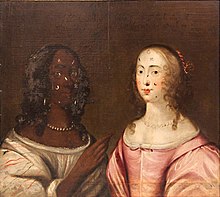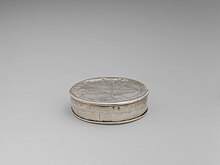|
Beauty mark A beauty mark or beauty spot is a euphemism for a type of dark facial mark so named because such birthmarks are sometimes considered an attractive feature.[1] Medically, such "beauty marks" are generally melanocytic nevus, more specifically the compound variant. Moles of this type may also be located elsewhere on the body, and may also be considered beauty marks if located on the face, shoulder, neck or breast. Artificial beauty marks have been fashionable in some periods. Artificial beauty marks HistoryThe wearing of artificial beauty marks trace back to the Roman Empire; it was believed that the Goddess of beauty, Venus, had a single beauty mark that accentuated her beauty.[3] As such, beauty patches became a recognizable symbol of beauty designed to highlight the pale, unblemished skin of the wearer.[4] In Europe, mouches (French, 'flies'), became fashionable in sixteenth-century France, and the fashion persisted into the eighteenth century. When the fashion spread to Spain and the Spanish Empire they were called a chiqueador.[5]   A mouche was generally made of paper, silk or velvet and was applied to the face as a form of make-up. They were kept in a patch box, or boîte à mouches ('box of flies'), and were often fanciful shapes such as hearts or stars. Patch boxes were often ornate, silver boxes, and formed an essential part of a woman's boudoir. Fashion prints from the late seventeenth century show women with an increasing number of beauty marks in a variety of sizes and shapes, placed on the cheeks, chins, and forehead. Besides their decorative value, the patches could hide smallpox scars or syphilis sores, as well as acne.[5] In 1668, the English diarist Samuel Pepys recorded attending the theatre and witnessing Barbara Villiers, one of the King's mistresses "called to one of her women… for a little patch off her face, and put it into her mouth and wetted it, and so clapped it upon her own by the side of her mouth, I suppose she feeling a pimple rising there."[6] Contemporary satire or beauty manuals like R. Smith's A Wonder of Wonders: or, a Metamorphosis of fair Faces voluntarily transformed into foul Visages attested the wearing of patches could "turn botches into beauty."[3] By the eighteenth-century, the wearing of patches also adopted social and political meaning. The placement or shape of a patch could reveal information about then wearer's relationship status, sexual availability, or political affiliations. Alexander Pope's 1712 poem The Rape of the Lock mentions such patches as indicators of "secular love":[7]
Criticism of the beauty patchMoral commentators in the early modern period increasingly expressed concern about the wearing of beauty patches, and linked it to sexual immorality and prostitution. The British diarist and intellectual John Evelyn referred to the wearing of patches, and make-up more general, as a "most ignominious thing."[8] Other commentators saw the wearing of a black patch as a physical symbol of the wearers black morals, or soul, commonly attributing the wearing of patches to signs of the wearer's vanity.[9] However, despite moral outcry, patches continued to be worn by men and women of diverse social ranks. Contemporary beauty patchesNatural beauty marks are also often enhanced with color from an eyebrow pencil or pen.[10] Celebrities with beauty marksMany female sex symbols, actresses, and other celebrities are known for their beauty marks:[10][11][12]
 Male actors known for their beauty marks include:[10]
In fictionJoan Crawford had a prominent beauty mark in her role as Sadie Thompson in Rain. Alicia Silverstone had a beauty mark on the left side of her mouth when portraying Batgirl in Batman and Robin. In the Kiff episode "Two Truths and a Bunny", Kennedy the lemur is confident that no one could top her in a game where one player must tell two facts and a fib, and the other participants must spot the fib. But Barry the rabbit, with some pointers from his sister, bests Kennedy in the game after Kennedy gives three statements which Barry finds out are all fibs. Barry then removes Kennedy's beauty mark which is actually a raisin.[13] See alsoReferences
Look up beauty spot in Wiktionary, the free dictionary. Wikimedia Commons has media related to Beauty spots. |